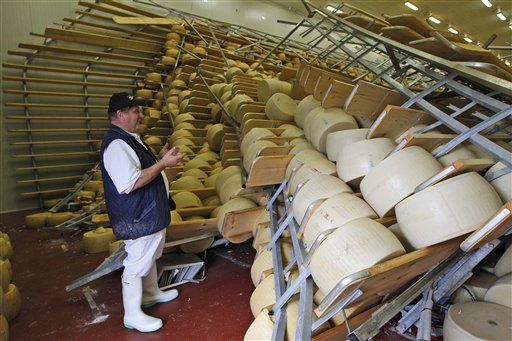
National farmers' group Coldiretti has estimated damage to agriculture in the area, one of Italy's most fertile and productive zones, at more than 200 million euros.
Some of the worst damage was to the production of Parmigiano Reggiano, also called Parmesan cheese, and its eternal rival, Grana Padano.
Both of the very hard seasoned cheeses are grated over pasta dishes, thinly sliced on salads or served in small, irregular pieces at fashionable parties worldwide.
Their respective passionate devotees can be compared to fans supporting different sports teams in the same town.
Some 300,000 wheels of Parmigiano Reggiano and 100,000 of Grana Padano, each weighing about 40 kg (88 pounds), were damaged when they fell off shelves in warehouses where they were undergoing the two-year-long seasoning process.
Coldiretti said some 10 percent of the production of Parmigiano Reggiano and two percent of Grana Padano was affected by the quake.
At a retail price of some 25 euros a kg ($15.00 a pound) in Italy and more abroad, Parmigiano Reggiano is one of Italy's most expensive cheeses. The area produces 3.3 million wheels of Parmigiano Reggiano a year.
Many Italian newspapers on Monday ran pictures of hundreds of big wheels of cheese that collapsed from seven-meter (23 feet)-high shelves piled like books on the floor of a bombed out library.
"We've lost two years of work," said Lorenza Caretti, whose family runs the Sant' Angelo cheese cooperative in the town of San Giovanni in Persiceto.
"We may be able to sell some of it for use in melted cheese products but that has only 20 percent of the value of the real thing," she said by telephone.
She said 22,000 wheels of hard cheese fell over in their warehouse during the quake.
"We still can't see the floor in many places," she said. "We will be lucky if we can somehow save half of it."
Production of milk used for cheese making in the area was also affected because many cows died in the collapse of stables or were left traumatized by the quake and its aftershocks, affecting the output and quality of milk, Coldiretti said.
Production of the Emilia-Romagna region's famed Prosciutto di Parma (seasoned Parma ham) was not believed to have been affected by the quake, an official of the Prosciutto di Parma consortium said.
While some pig farmers in the quake area saw their herds killed or injured, most of the pigs come from other parts of northern Italy and only the production process itself takes place in the Parma area, which was not hit, she said.



... not the cheese. Oh the humanity. *sobs*